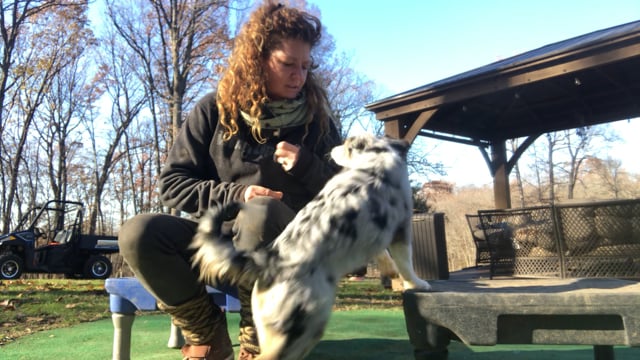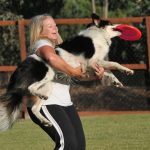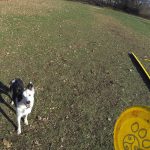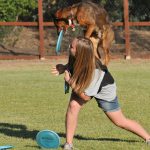


This is the first of a 4 part session with Motown, an 18 month old MiniAussie. Motown is easily over-aroused while working for cookies. He is Apryl’s dog and she handles him fine. He is still over-aroused, but manageable for her if she stays on top of him. I am not a fan of “staying on top” of a dog. I try to cultivate a sense of self-discipline with a working dog, which is often easier said than done and certainly easier done with a dog who is not yours.
Session 3 with Motown shows a significant reduction of arousal and a marked increase in DriveDrive is focus and energy applied towards work. There are many kinds of Drive: social drive, tracking drive, prey drive, bite/kill, stalking, and food to name a few. Social drive, prey drive, and... More. Drive is energy and action applied towards work. Building off of Session 1 and Session 2, we’re moving forward with an increased level of criteria for the target behaviors and are adding Attention, or unsolicited eye contact Unsolicited eye contact or Attention is a great way to hook up with a dog. If you have something the dog wants he should give eye contact in order to get access to... More to the mix to add some additional structure for further reduction of arousal and increased Drive.
Unsolicited eye contact or Attention is a great way to hook up with a dog. If you have something the dog wants he should give eye contact in order to get access to... More to the mix to add some additional structure for further reduction of arousal and increased Drive.
Ron & Grasshopper work on a Dog Catch A Dog Catch is a great trick to use for hitting the crowd or for putting a strategic pause in your routine. The dog leaps to catch the disc and then you catch... More, Pedestal, and Wait
A Dog Catch is a great trick to use for hitting the crowd or for putting a strategic pause in your routine. The dog leaps to catch the disc and then you catch... More, Pedestal, and Wait Waiting on cue and situationally is extremely important for disc dog freestyle training. The competition field might not see too much waiting going on as everything is supposed to be happening in flow,... More vs Stay in this training session featured in DiscDogger Weekly #24. Getting a Dog Catch is a good thing, but getting a Dog Catch while clearly communicating Wait vs Stay and installing a trigger for the Dog Catch is elegant and efficient and the way that we like to do things at Pawsitive Vybe.
Waiting on cue and situationally is extremely important for disc dog freestyle training. The competition field might not see too much waiting going on as everything is supposed to be happening in flow,... More vs Stay in this training session featured in DiscDogger Weekly #24. Getting a Dog Catch is a good thing, but getting a Dog Catch while clearly communicating Wait vs Stay and installing a trigger for the Dog Catch is elegant and efficient and the way that we like to do things at Pawsitive Vybe.
This is session 2 of Wait vs Stay via the Back Stall A Stall happens when your dog leaps up and stays on a part of your body. Stalls are usually named by the part of your body they happen on. If your dog leaps... More with Motown that took place a couple of minutes after session 1. In this session Motown is more calm and thoughtful and displays a bit more drive and much less arousal. We’ll be building on the stuff we covered in session 1 in this second of 4 sessions.
A Stall happens when your dog leaps up and stays on a part of your body. Stalls are usually named by the part of your body they happen on. If your dog leaps... More with Motown that took place a couple of minutes after session 1. In this session Motown is more calm and thoughtful and displays a bit more drive and much less arousal. We’ll be building on the stuff we covered in session 1 in this second of 4 sessions.
Ron & Soda Pop use the Flatwork Compass The Flatwork Compass is a disc dog form that separates the Flank from the Pass, creates a reliable trigger, and exposes the team to all of the key elements of Team Movement. https://www.youtube.com/watch?v=xW7Czz-7ows&list=PL8zWXaJfi1-synGOkBJ7u4p-WkotsL3LR... More to install the Wait behavior and a reliable Trigger for action.
The Flatwork Compass is a disc dog form that separates the Flank from the Pass, creates a reliable trigger, and exposes the team to all of the key elements of Team Movement. https://www.youtube.com/watch?v=xW7Czz-7ows&list=PL8zWXaJfi1-synGOkBJ7u4p-WkotsL3LR... More to install the Wait behavior and a reliable Trigger for action.
In a recent piece I laid out 3 Disc Quan Do Forms that work in concert to create competent interior play. Let’s focus in on one of them, the Balanced PositionIn the Play+ philosophy, "Position" is the final stage within the "Next" phase of a Cycle of Play. It acts as a pivotal link between the "Next" phase and a new "Now" phase. More Form, and explore how and why it works and how it scales up.
There was a problem reporting this post.
Please confirm you want to block this member.
You will no longer be able to:
Please note: This action will also remove this member from your connections and send a report to the site admin. Please allow a few minutes for this process to complete.



Responses